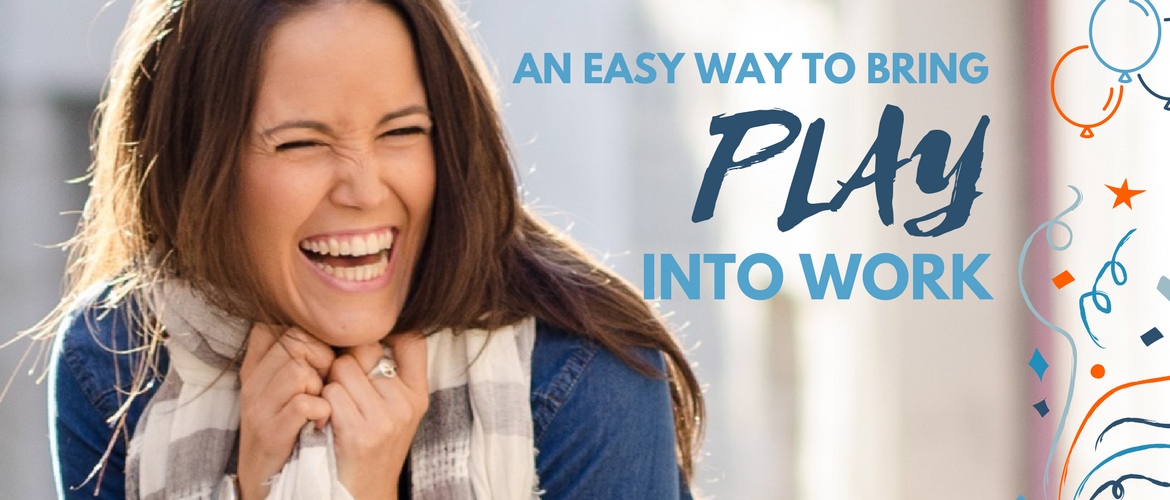Creativity and innovation are critical in business. Nurturing these skills enables us to stand out in an overcrowded marketplace. But how do you find the right balance between the seriousness of work and the playfulness of well… play?
As children, our creativity, playfulness, our ability to stand out and say something clever or be different, outrageous, or unusual is celebrated.
How many times has a proud parent relayed to you a story of something clever or brilliant their child has said? Then what happens? We go through the education system to ‘learn’ and to absorb new knowledge and new skills and in the process, somehow our capacity to think for ourselves begins to shut down. We are taught to toe the line, to fit in. Standing out, being different is shunned upon and ridiculed. We are taught there is a right answer and a wrong answer, we are rarely encouraged to seek out an alternative answer. We learn to get the answers right so we can fit into a system which rewards accordingly.
By the time we are adults, that creative streak in us that was celebrated and acknowledged and even honoured as a child has been shut down as an adult. Our inner critic speaks up and says, ‘You can’t think that!’ ‘You can’t do that!’ ‘That won’t work!”.
At work, we have become conditioned to sitting and listening to managers, educators, and speakers conveying information instead of skilled facilitators that invite us to interact with the material in order the drive the lessons deeper. When we apply this conditioning to our business, we can see how it prevents us from taking risks, challenging the status quo, and thus gaining that competitive edge in the marketplace. I believe it’s time organizations commit to nurturing a culture of playfulness in the workplace. Employees will be happier for it and their business has a higher chance of thriving from it.
Now when I ask some people about what comes to mind when they think about play at work, they immediately think of hammocks and ping pong tables in the office a la google. What most people miss that is THE key to their overwhelming success- and what got them voted as #1 out of the 100 Best Companies to Work For in 2017– is they make play a core part of the working environment.
One of the most frequently asked questions from people I get is, “But Leena, isn’t work supposed to be serious? How do we, as a company, balance creating a dynamic, fun, collaborative office space and not overstep the line to nurturing a space that is lax and unproductive? If we put in a bunch of ping-pong tables in our office, how will anyone get anything done?’
So let’s address this dichotomy.
Tech startups have become known for their hip office spaces. They are a symbol of how creativity has taken center-stage and work spaces are more and more being designed to ignite innovation amongst employees. However, a foosball table, zen meditation space, or even a bowling alley in your office will not change a thing if playfulness, creativity, and innovation is not integrated into your culture. You’ve got to be intentional with how you create your office culture and let your workspace be a reflection of that.
What’s office culture, you say?
Quite simply, it’s the personality of a company. It defines the environment in which you work, as well as your company’s mission, values, and goals. It can be identified in the way you and your co-workers interact with each other, the pictures and posters on the walls, the notices on the bulletin board, the language and tone of messages in an email, and many other small but impactful, ways.
Don’t fall into the trap of simply exchanging ping-pong tables for purpose in the office. Do these instead:
- Look at what you want your business to represent and then build your environment accordingly.
- Have a vision people are inspired by.
- Do meaningful work that does more than putting a dollar in an employee’s pocket.
Recent research found that today’s generation are prioritizing purpose in their work. If you haven’t caught on to this yet, and you have a significant number of millennials in your workplace, you may need to re-think your business operations. However, if you want a low-cost way to improve morale, help employees take a break from their desks, foster friendly competition, or help increase alertness and concentration, while getting the endorphins going, providing recreation outlets are a great option.
The bottom line? The genius of the AND vs OR is you don’t have to sacrifice one over the over.
It’s not fun and games at Google for the sake of it. It’s strategic. At the same time, play needs to be anchored into the heart and soul of your company -otherwise it will feel fake. When I walked into the Google campus and witnessed their bowling alley, meditation pods, dance classes, and slides employees jump on to take them from one floor to the one below, I immediately felt that play, fun, creativity, and balance of mind and body were integral to the high performance of employees. It wasn’t a show they were putting on (though I could see their employees were clearly proud of the environment they were part of). The environment was created in this way because their leaders genuinely believe that when people play at work, their right brain is engaged, they are more in flow, and more likely to innovate. What Google have done successfully is created a structure for unstructured time.
Innovation needs time to develop and when you are on a time crunch, busy putting out fires and chasing short-term goals- and let’s face it, that’s almost all of us, all the time- research shows that creativity is dampened. Dedicating a percentage of time (Google give their employees 20%) to play with new ideas gives people permission to be in a state of discovery without purpose or agenda. The idea is to nurture an environment that enables employees to give up control when the pressure is greatest, and give the brain a chance to remember what it is like to be a kid in a sandbox again.
How is your organization nurturing play in the workplace?
Over the last 5 years, I have been testing out a new style of learning at work I call Gamulation – I’ve discovered this method has not only helped businesses and other organizations survive, but thrive, while actively preparating them for the demands of work in the future. To find out how strategic play in the workplace can help your people learn, create, and innovate, watch this TEDx talk.
Let’s spread the message that play at work should be the norm not the exception.
Let’s get workforces thriving and playful and thinking outside the box.
Let’s be the change.
See you in the sandbox!
Originally published at www.leenapatellive.com


